
Đề Luyện Thi ACT Science Practice Test 4 - Miễn Phí, Có Đáp Án, Giải Thích
Từ khoá: ACT Science luyện thi ACT bài thi thử miễn phí có đáp án có giải thích phân tích dữ liệu tư duy khoa học luyện đề ACT
Đề thi nằm trong bộ sưu tập: Tuyển Tập Bộ Đề Thi Đại Học Hoa Kỳ (ACT) - Có Đáp Án Chi Tiết
Số câu hỏi: 22 câuSố mã đề: 1 đềThời gian: 1 giờ
219,779 lượt xem 16,899 lượt làm bài
Xem trước nội dung:
The oceans of Earth are exposed to various climates and consequently have different physical properties. Deep oceans can be divided into zones based on temperature gradient and penetration of sunlight. Figure 1 shows the zones of a typical deep-water ocean, the depth of the zone boundaries in meters (m), and the overall pressure at those depths in kilopascals (kPa). Figure 2 shows the water temperature in degrees Celsius (°C) in warmer tropical oceans and cooler temperate oceans at varying depths. Sound waves are used to measure water temperature at depth, and readings from two different ocean regions are recorded in Table 1.
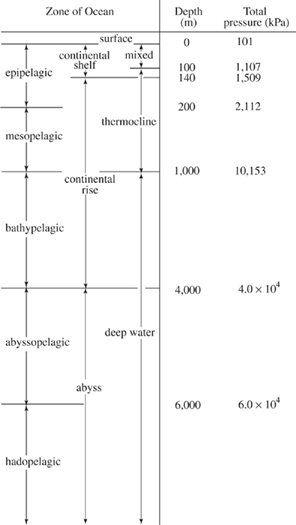
Figure 1
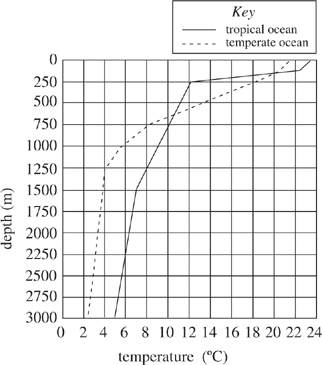
Figure 2
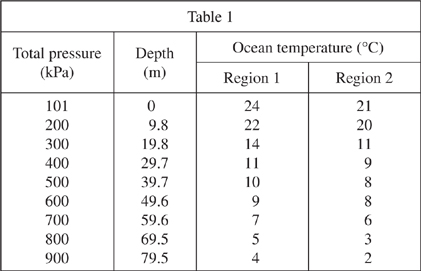
According to
Figure 1, the regions of several ocean zones overlap. Which of the following pairs of ocean zones share part of a common depth range?
Bathypelagic and mesopelagic
Bathypelagic and epipelagic
Epipelagic and thermocline
Epipelagic and mesopelagic
According to
Figure 1, an oceanographic reading taken at a total pressure of 1,200 kPa is most likely from which of the following zones?
Abyss
Continental rise
Mixed
Continental shelf
According to
Figure 2, a sonographic measurement of temperature would be unable to distinguish the difference between tropical and temperate oceans at which of the following depths?
250 m
500 m
625 m
750 m
According to
Table 1, the relationship between depth and ocean temperature is best described by which of the following statements?
The water temperature increased with increasing depth in Region 1 only.
The water temperature decreased with increasing depth in Region 1 only.
The water temperature increased with increasing depth in Region 2 only.
The water temperature decreased with increasing depth in Region 2 only.
According to
Figure 1 and
Table 1, if water temperature measurements were taken at depths greater than 79.5, the total pressure at those depths would most likely:
decrease to less than 101 kPa.
increase to more than 900 kPa.
stay at 900 kPa.
increase to 101 kPa.
Although many forms of bacteria are helpful for human health, they can also cause illness and even death from severe infections. Antibiotics are a class of medicines used to combat bacterial infections. Bacteriostatic activity inhibits bacteria cell division and bactericidal activity kills bacterial cells. Both actions eliminate populations of bacteria over time. Several classes of bacteriostatic and bactericidal antibiotics are described in Table 1.
The effectiveness of several antibiotics against a bacterium known to cause common skin infections was tested. Drugs were introduced to the bacterial culture by themselves or in combination with sulfamethoxazole (forming SMX compounds). The effectiveness of these antibiotics at eliminating the responsible bacterium is shown in Figure 1.
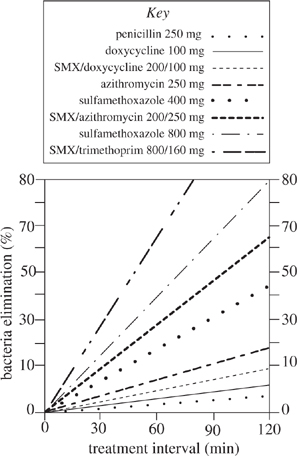
Figure 1
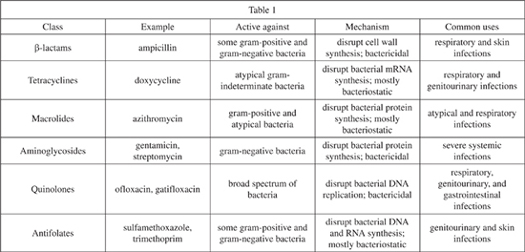
According to the information in
Table 1 and
Figure 1, what can be concluded about the use of sulfamethoxazole as an antibiotic for common skin infections?
Using sulfamethoxazole 800 mg is ineffective as an antibiotic.
Increasing the dosage of sulfamethoxazole decreases its overall effectiveness as an antibiotic.
As an antibiotic, the mechanism of action of sulfamethoxazole is unknown.
Compounding antibiotics with sulfamethoxazole increases their effectiveness against common skin infections.
According to
Figure 1, if an investigator administered a sulfamethoxazole dose of 600 mg, 20% of the original bacteria would remain after a treatment interval:
greater than 120 min.
between 90 and 120 min.
between 60 and 90 min.
between 30 and 60 min.
After treatment of a bacterial culture similar to that in the passage with 250 mg of penicillin for 2 hours, the culture will probably contain:
less bacteria overall, but most will have survived.
less bacteria overall, and most will have been killed.
the same amount of bacteria overall, and most will have survived.
the same amount of bacteria overall, and most will have been killed.
Is the statement “antibiotics compounded with sulfamethoxazole are more effective against common skin infections than when administered alone” supported by the information shown in
Figure 1, and why?
No, because penicillin is more effective against a common skin infection bacterium than sulfamethoxazole 400 mg.
No, because azithromycin is more effective against a common skin infection bacterium than SMX/azithromycin.
Yes, because sulfamethoxazole 800 mg is more effective against a common skin infection bacterium than SMX/azithromycin.
Yes, because SMX/doxycycline is more effective against a common skin infection bacterium than doxycycline.
According to the passage, the most effective antibiotic against bacteria is one that results in the:
lowest percentage of bacterial elimination in the shortest treatment interval.
lowest percentage of bacterial elimination in the longest treatment interval.
greatest percentage of bacterial elimination in the shortest treatment interval.
greatest percentage of bacterial elimination in the longest treatment interval.
A study was conducted regarding the fossil shells of a particular species of turtle that lives off the coast of the Opulasian Peninsula. Scientists discovered a continuous record of fossilized shells in the seabed off the coast dating back 120,000 years. In addition to examining the fossilized turtle shells, the scientists also examined the shells of living turtles.
From each layer of seabed, the scientists randomly selected five complete, unbroken fossilized shells. Each shell was carefully prepared, measured, and photographed. A bit of each shell was then clipped off and sent to a laboratory for radiocarbon dating to determine the precise age of each shell.
Study 1
All of the living turtles had a distinct band of hexagonal scutes (bony plates) running the length of their shells, from head to tail. The fossilized shells' scutes were not visible to the naked eye; however upon application of a particular dye, a similar band of scutes from head to tail was observed in every shell.
Scutes extending greater than  of the length of the shell were labeled major (M), where scutes extending less than or equal to
of the length of the shell were labeled major (M), where scutes extending less than or equal to  of the length of the shell were labeled minor (m). The pattern of scutes was recorded for each fossil. For each time period, the percent of fossils exhibiting each pattern is given in Table 1.
of the length of the shell were labeled minor (m). The pattern of scutes was recorded for each fossil. For each time period, the percent of fossils exhibiting each pattern is given in Table 1.
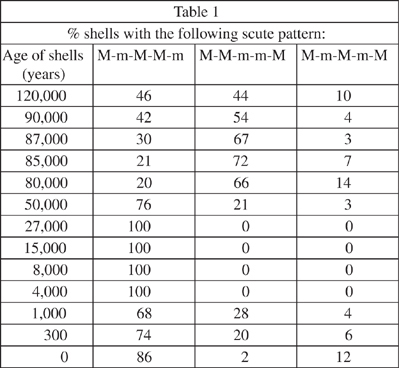
Study 2
For each shell, the surface area of the shell, the height of the shell's bridge (the part of the shell linking the upper and lower plates), and the total number of scutes were recorded (see Figure 1).
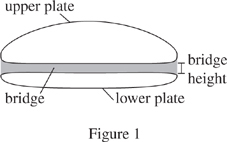
For the shells of each age, the average of each measurement was calculated. The results are presented in Figure 2.
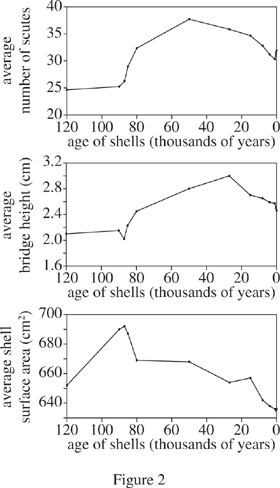
In a layer of seabed determined to be 250,000 years old, the scientists found fragments of twelve turtle shells, but no complete, intact shells. Which of the following is the most likely reason this layer of seabed was not included in the studies?
250,000 years is too old to obtain an accurate radiocarbon date.
Shells that were 250,000 years old would have been irrelevant to the studies.
Accurate measurements of the dimensions of the shells could have been impossible to obtain.
The scientists would not have been able to accurately determine the color of the shells.
With regard to the descriptions given in Study 1, the shells with the M-M-m-m-M band of scutes probably most closely resembled which of the following?
 .
.
 .
.
 .
.
 .
.
According to the results of Study 2, how do the average number of scutes and the average bridge height of living turtles of the Opulasian Peninsula compare to those of the turtles of the Opulasian Peninsula from 120,000 years ago? For the living turtles:
both the average number of scutes and the average bridge height are larger.
both the average number of scutes and the average bridge height are smaller.
the average number of scutes is larger, and the average bridge height is smaller.
the average number of scutes is smaller, and the average bridge height is larger.
Suppose, in Study 1, the scientists had found another seabed layer with fossilized shells that were radiocarbon dated and found to be 86,000 years old. Based on the results of Study 1, the scute pattern percents for the group of shells would most likely have been closest to which of the following?
M-m-M-M-m
100%
50%
36%
26%
In Study 2, the average shell surface area of fossilized turtle shells that were 80,000 years old was closest to:
670 cm2
680 cm2
690 cm2
700 cm2
Which of the following statements best describes how Study 1 differed from Study 2?
In Study 1, the scientists examined 3 characteristics regarding the shape and size of turtle shells; but in Study 2, the scientists examined the frequency of occurrence of different patterns of scutes on turtle shells.
In Study 1, the scientists examined the frequency of occurrence of different patterns of scutes on turtle shells; but in Study 2, the scientists examined the environment in which turtles live.
In Study 1, the scientists examined the frequency of occurrence of different patterns of scutes on turtle shells; but in Study 2, the scientists examined 3 characteristics regarding the shape and size of turtle shells.
In Study 1, the scientists examined 3 characteristics regarding the shape and size of turtle shells; but in Study 2, the scientists examined the environment in which turtles live.
The 4 different blood types in sheep are A, B, AB, and O. The blood type of an offspring is determined by the blood types of its parents. Each parent contributes a single gene to its offspring, forming a pair of genes. The genotype of an offspring refers to the arrangement of the offspring's new gene formed by the combination of the parents' genes.
There are three possible alleles (forms) of this gene: the type-A blood allele (IA), the type-B blood allele (IB), and the type-O blood allele (IO). Both IA and IB are dominant to IO, and IO is recessive to IA and IB. This means that an individual with 1 IA and 1 IO will have type-A blood, and an individual with one IB and one IO will have type-B blood. When an individual has one IA and one IB allele, this individual will have type-AB blood, due to the codominance of the IA and IB alleles.
| Table 1 | |
| Blood Type | Possible Genotypes |
| A | IAIA or IAIO |
| B | IBIB or IBIO |
| AB | IAIB |
| O | IOIO |
To explore the inheritance patterns of blood types in sheep, researchers conducted 4 analyses. In each analysis, male and female sheep of differing blood types were mated and the resultant blood types of their offspring recorded.
Analysis 1
One thousand males with type-O blood were mated with 1,000 females with type-AB blood. The following blood types were observed in the offspring:
Type A: 50%
Type B: 50%
Analysis 2
Two hundred of the type-A offspring from Analysis 1 were mated with 200 type-O mates from no previous experiment. The following blood types were observed in the offspring:
Type A: 50%
Type O: 50%
Analysis 3
One hundred of the type-A offspring from Analysis 1 parented children with 100 type-B offspring from Analysis 1. The following blood types were observed in the offspring:
Type A: 25%
Type B: 25%
Type AB: 25%
Type O: 25%
Analysis 4
Twenty-five of the type-A offspring from Analysis 3 were mated with type-B mates with Genotype IBIB who were not from any previous analysis. The following blood types were observed in the offspring:
Type AB: 50%
Type B: 50%
The ratio of blood types containing at least one IA allele to the blood types containing at least one IB allele produced in Analysis 3 was:
1:00
1:01
2:01
3:01
An offspring whose blood type exhibits codominance has which of the following genotypes?
IBB
IBO
IAB
IAO
To produce only offspring with AB blood, one would mate two sheep with which of the following sets of genotypes?
IABAB
IABOO
IAABB
IBBAO
In Analysis 3, the offspring used from Analysis 1 most likely had which of the following genotypes?
IAOBB
IAOBO
IAABB
IAABO
Some or all of the offspring had 1 allele for type-O blood in Analyses:
1 and 2 only.
2 and 3 only.
1, 2, and 4 only.
1, 2, 3, and 4.
Suppose that 300 offspring were produced in Analysis 3. Based on the results, the number of offspring with type-B blood produced in Analysis 3 would most likely have been closest to:
25
50
75
100
Đề thi tương tự
30 mã đề 1181 câu hỏi 1 giờ
223,117 xem17,161 thi
6 mã đề 300 câu hỏi 1 giờ
187,811 xem14,433 thi
17 mã đề 679 câu hỏi 1 giờ
333,000 xem25,611 thi
15 mã đề 600 câu hỏi 1 giờ
234,641 xem18,044 thi
26 mã đề 910 câu hỏi 1 giờ
318,809 xem24,521 thi
19 mã đề 802 câu hỏi 1 giờ
273,953 xem21,069 thi
8 mã đề 320 câu hỏi 1 giờ
230,740 xem17,746 thi
